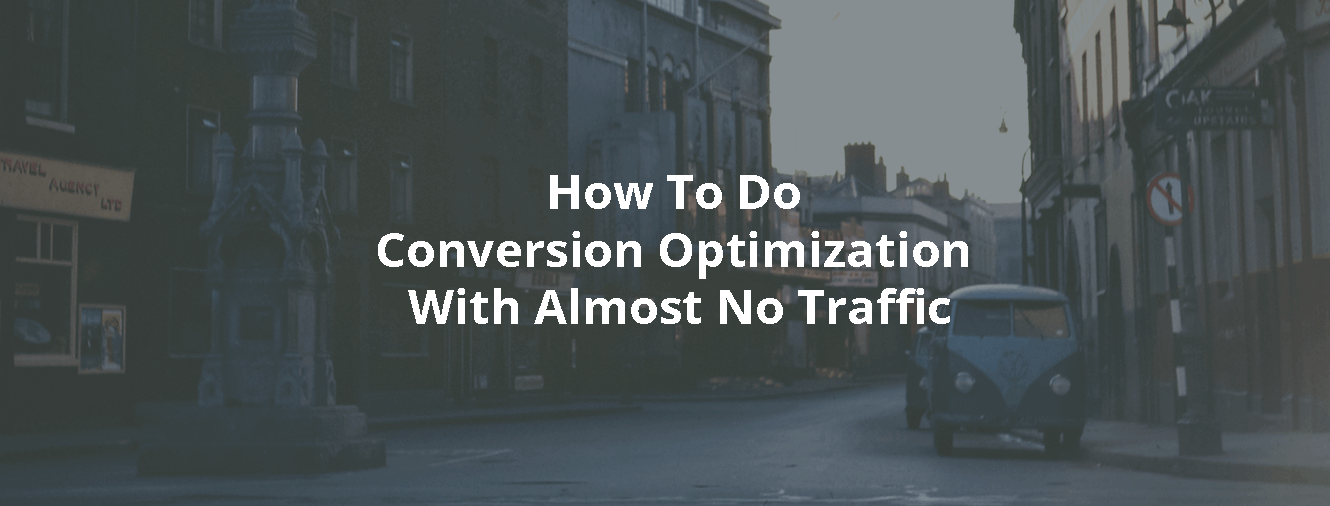
We already talked about the importance of Conversion Rate Optimization before and got the basics worked out for your company website to start with Conversion Rate Optimization. At its core conversion optimization is the idea of testing out different versions of your pages, different copy, different visuals, etc. to make the pages get as much conversion as possible.
“I have too little traffic to test; hence, I can’t do conversion optimization.”
However, to conduct a scientific test, you need enough visitors to increase your conversion rate and enough conversions to generate good results. According to Launchbit is saying that you need a minimum of 100 visitors to each landing page with at least 20 conversions for a test to achieve statistical significance (a recommended 95%).
But what if your website doesn’t quickly generate this amount of traffic and converts even less? This scenario happens to marketers quite often and leaves many wondering if split testing can be effective or if CRO is even right for their company.
The answers are: Of course it can and CRO is right for everyone. You just need a slightly different approach. Here’re a few ways that you can make CRO and testing more effective, even if you don’t have enough traffic.
#1 Test the Page with the Most Traffic
It’s easy to think you need to start running tests on the page that you think will impact your conversion rates the most, like the checkout page or the page where you visitors can request a quote. However, it is more likely that your home page gets more individual visits than any other page on your website. So start with your homepage (or the page on your site which gets the most traffic).
Start testing elements on your most visited page, which can be used to improve results on other lower-traffic pages on your site. A side effect of you improving your homepage is that traffic towards your lesser visited pages will improve. As a result, you will start to get more traffic on those pages to start running tests on them as well.
#2 Reduce Variations
The idea behind this is pretty simple: The more variations you’re adding of a single page, the lesser amount of traffic each variation will receive.
If your page received 100 visitors per month, then you will have to divide those visitors between the existing page and all variations you want to test.
Coming back to our example of 100 visitors per month, if you create a new variation, it will mean that both versions only get 50 visitors. If you add another version, it will mean that each version will only get 33 visitors, etc.
More traffic translates to increased time before you can begin to see a valid result. Keep it simple with just an A/B test so you can see qualitative results faster.
#3 Make Big Changes
If the conversion rate for version A and version B is almost the same, then you will need a lot more visitors before you can be sure which of the two versions is the winning one.
An alternative would be to test more elements on one challenger page. A more dramatic version will be more likely to produce bigger differences in your conversion rate. A bigger difference in conversion rate means you will need fewer visitors on your page before you can announce a winner.
#4 Test Goals With Better Conversion Rates
You have a choice of things to optimize for and generally, it’s best to optimize for things that produce revenue – so you might want to optimize for sales, or leads generated for instance.
Unfortunately these sorts of things have lower conversion rates, which means that they take longer to test. Testing for bounce rate, time on page, click through, comments on your blog, file downloads or just adding items to a wish list, have much higher conversion rates. As a result tests for these goals take less time to conclude.
#5 Testing for Secondary Goals
Similar to making a test with easier goals for conversion rate, testing for secondary goals on a page like bounce rate, time on page or click-through rate can sometimes be impactful enough to optimize.
While reducing your bounce[URL] rate won’t necessarily increase your sales directly, you may find that reducing bounces increases engagement and other types of conversions.
#6 Test Lots of Things
When you reduce variations of a page, it doesn’t mean you can’t run simultaneous tests on different pages. Doing this won’t speed up the individual tests, but it does mean you can get more results faster than waiting till one test on a page is finished and then moving on to the next.
For example, you test the copy and headlines on your homepage where you’re trying to reduce the bounce rate. While you run a test for email signups on your blog post pages at the same time.
Watch out, you need to be careful to not run tests on one page, which has an impact on another page while you run a test on that second page as well.
For example: if you run a test on your homepage, and a page that links directly from your homepage, one variation of your homepage might send a different quality of traffic to that follow-up page than another.
Because of this it might be difficult to assess the tests run on your follow-up page.
Ideally, in this case, you would want to test all four combinations:
- Homepage A with follow-up page A
- Homepage A with follow-up page B
- Homepage B with follow-up page A
- Homepage B with follow-up page B
For this to work out properly, however, you will need a lot of traffic again. Because the reason we’re testing it like this is because you don’t have that much traffic yet, it’s best only to run tests on pages that are not directly linked in your funnel.
#7 One Test To Rule Them All
Next to testing multiple pages at once, you can also start testing a couple of recurring elements on all your pages. A great example for this is your navigation bar, but other items include your header and logo or your colour palette.
As discussed with point 3, try to make the changes as big as possible to get better and fast results.
You might not be able to run multivariate tests, but you can still do conversion optimization on your website if you got low traffic. Don’t wait till you got lots of traffic on your website, because the sooner you start collecting data, the sooner you start learning about your website and your visitors. No excuses, get to work!
Any other tips you are using on your low traffic website that can help others? Please, them below in the comments!

